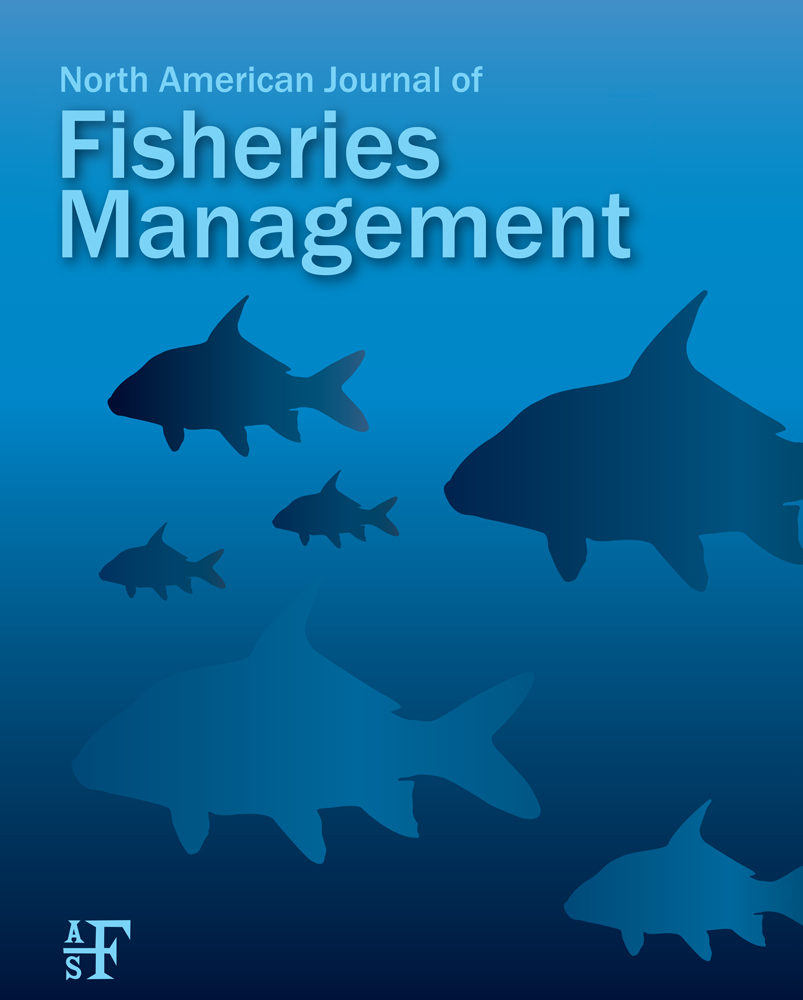Age-0 Sturgeon Accessibility to Constructed and Modified Chutes in the Lower Missouri River
Abstract
Shallow-water habitat is hypothesized to provide nursery habitat for young fish. The construction of side-channel chutes to restore shallow-water habitat is common in the lower Missouri River; however, a recent adaptive management strategy document (developed by a multiagency, multidiscipline team), as well as previous research, has suggested that the accessibility of chutes to age-0 Scaphirhynchus spp. (sturgeon hereafter) may be limited. Access is a critical prerequisite for young fish utilizing chute habitat; thus, we investigated chute-specific accessibility for age-0 sturgeon at seven chutes (constructed and natural). Age-0 sturgeon were capable of accessing most chutes; however, accessibility appeared limited at sites with highly restrictive inlet structures. Our results suggest that future consideration of chute inlet designs that meet authorized Missouri River purposes while providing improved fish access is warranted. Additionally, capture sites for exogenously feeding age-0 sturgeon were usually deeper (>1.5 m) and faster (>0.5 m/s) than sites without sturgeon in chute and adjacent main-stem habitats. This finding is consistent with previous research that suggests that slow and shallow habitats may not be used by age-0 sturgeon as frequently as other habitat types in the lower Missouri River.
Received June 4, 2014; accepted September 24, 2014
The Missouri River was highly modified during the 20th century for the purposes of bank stabilization, flood control, commercial navigation, hydropower generation, and water supply. While these measures were effective in protecting and benefiting numerous human interests, the negative effects of river regulation were also evident with declining habitat diversity as the Missouri River shifted from extensive areas of warm, shallow, and turbid habitat (i.e., shallow-water habitat [SWH]) to extensive areas of relatively cold, deep, and clear habitat (USFWS 2000, 2003; NRC 2011). As a result, many native species declined (Hesse et al. 1989; Galat et al. 2005; NRC 2011) and the Pallid Sturgeon Scaphirhynchus albus was listed as endangered in 1990 (USFWS 1990). Subsequently, the U.S. Fish and Wildlife Service issued a Biological Opinion and amendment (collectively referred to as BIOP) on the U.S. Army Corps of Engineers (USACE) operation of the Missouri River system (USFWS 2000, 2003). One element of the reasonable and prudent alternative identified in the BIOP was the development of 5.0–7.6 ha/km of SWH from Sioux City, Iowa, downstream to the mouth of the Missouri River near St. Louis, Missouri.
As a result, the USACE began actively restoring SWH (defined as depth ≤ 1.5 m and velocity ≤ 0.6 m/s and further clarified by the U.S. Fish and Wildlife Service to include “side channels, backwaters, depositional sandbars detached from the bank, and low-lying depositional areas adjacent to shorelines”) to benefit Pallid Sturgeon. Estimates suggest that over 1,300 ha were restored as of the most recent SWH accounting report (Jalili and Pridal 2010), with additional restoration projects completed since. To date, evidence suggests that little Pallid Sturgeon recruitment has occurred in the lower Missouri River (LMOR; Steffensen et al. 2014); however, only ∼3% of the more than 40,000 ha of SWH lost as a result of river modification has been restored (USACE 2003; Jalili and Pridal 2010). Detailed evaluation of the SWH management action is needed given the expense, complexity, and uncertainty inherent in implementing a large-scale habitat restoration effort. Although project-specific objectives are important for evaluating hypothesized linkages between SWH actions and Pallid Sturgeon, the fundamental objective (Pallid Sturgeon population increase via increased natural recruitment) will ultimately determine if SWH creation efforts successfully reduce the negative impacts of USACE operations on Pallid Sturgeon. Thus, a SWH evaluation strategy (USACE 2012) was developed by a multiagency, multidiscipline team, using an adaptive management approach, to evaluate the ability of habitat restoration actions to provide the hypothesized benefits related to physical habitat and biological response. This evaluation strategy uses a nested approach emphasizing a systemwide response of increased survivorship and population growth for Pallid Sturgeon but also provides a framework for evaluation at the project scale to determine if the desired physical and biological responses are occurring locally. Both long-term (i.e., natural recruitment of Pallid Sturgeon) and shorter-term (e.g., increased retention of age-0 sturgeon, increased food availability) evaluation are necessary to assess the effectiveness of SWH restoration as a management action for Pallid Sturgeon population growth (which may take decades) while providing information to support short-term decision making related to SWH restoration projects.
An intent of SWH restoration is to provide nursery habitat for exogenously feeding Pallid Sturgeon (USACE 2012). The construction of side-channel chutes is a common method used to address the intent of SWH restoration projects (Gosch et al. 2013), and to date the USACE has constructed over 20 chutes (Heimann et al., in press). The accessibility of constructed chutes to age-0 Scaphirhynchus spp. (sturgeon hereafter) is an important prerequisite to habitat use, and access could be affected by various factors, including chute design, inlet control structure, river degradation, and age-0 sturgeon locomotor capacity (USACE 2012). Ridenour et al. (2011) studied the habitat use of age-0 sturgeon on the LMOR, finding lower age-0 sturgeon catch rates in chute habitat than several other mesoscale habitats. The authors suggested that limited accessibility may be an issue; however, no analysis of chute-specific effects was conducted and accessibility could vary greatly among chutes. Thus, our primary objective was to evaluate chute accessibility for LMOR age-0 sturgeon by comparing catch rates between chute and adjacent main-stem habitats at a variety of constructed and natural chutes, including a chute with an inlet structure specifically designed to increase free-embryo drift access. This information is an important component for evaluating the success of completed SWH projects and guiding adaptive management efforts on the LMOR.
METHODS
The LMOR extends more than 1,300 km downstream from Gavins Point Dam, South Dakota, to the confluence of the Mississippi River at St. Louis, Missouri. Seven chutes from Peru, Nebraska, downstream to St. Louis, Missouri, were selected to represent a range of natural and constructed chutes of different ages (Figure 1). Constructed chutes included the following: Upper Kansas (river kilometer [rkm] 878 [measured from the confluence with the Mississippi River]; constructed in 2005), Rush (rkm 806; constructed in 2007), Worthwine (rkm 737; constructed in 2006), Jameson (rkm 344; construction began in 2007 but ceased due to stakeholder concerns [see Gosch et al. 2013 for more detail], and river flows completed the chute in 2010), and Overton (rkm 301; constructed in 2003). Inlet control structures limiting the amount of main-stem flow (≤10%) into each chute were constructed. Additionally, the Jameson chute inlet was constructed with a unique, V-shaped grade control structure specifically designed to allow access to deep-drifting sturgeon larvae. The natural chutes included Lisbon (rkm 351; located on the next bend upstream of Jameson) and Pelican (rkm 26). Lisbon was formed by high water events during 1993–1996 (Jacobson et al. 2004) and is relatively young compared with Pelican, which was present on maps as early as the 1890s (Missouri River Commission 1895). Although these two chutes formed naturally, they are considered modified as control structures were also constructed in these chutes. All control structures (in both modified and constructed chutes) were designed to maintain other authorized Missouri River purposes and constructed based on site-specific conditions, resulting in designs with varying degrees of flow restriction. The elevation of each control structure is a potential barrier limiting age-0 sturgeon access; therefore, invert elevation (the lowest point on the control structure representing the minimum elevation at which water can flow over the structure) and water surface elevations (from the nearest U.S. Geological Survey gauge station) relative to the Missouri River Construction Reference Plane (defined as the 75% exceedance probability water surface elevation during the navigation season [Jacobson et al. 2009]) were used to describe invert elevation differences among chutes. Lisbon and Pelican were the only chutes where invert elevation exceeded water surface elevations during extended portions of the 2012 and 2013 sampling seasons (Figure 2). Additionally, Upper Kansas and Lisbon chute entrances are mostly blocked with revetment rock (Figure 3). As a result, Upper Kansas, Lisbon, and Pelican were considered highly restricted relative to the other chutes.
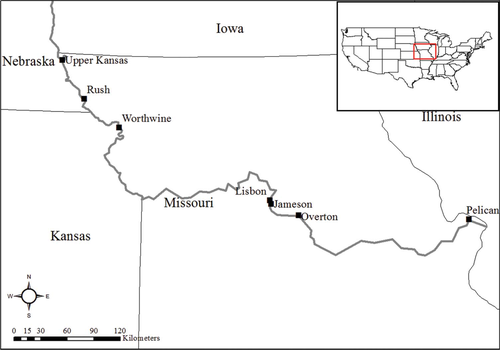
Map of constructed and modified study chutes (denoted by black squares) on the lower Missouri River.
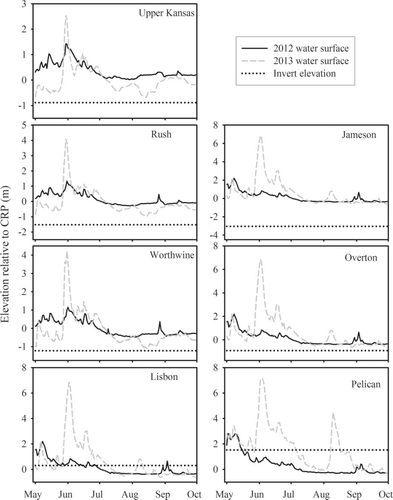
Control structure invert (i.e., the minimum elevation at which water can flow over the structure) and water surface elevations (based on the nearest U.S. Geological Survey gauge station) for each chute during the 2012 and 2013 sampling seasons relative to the Missouri River Construction Reference Plane (CRP; 75% exceedance probability).
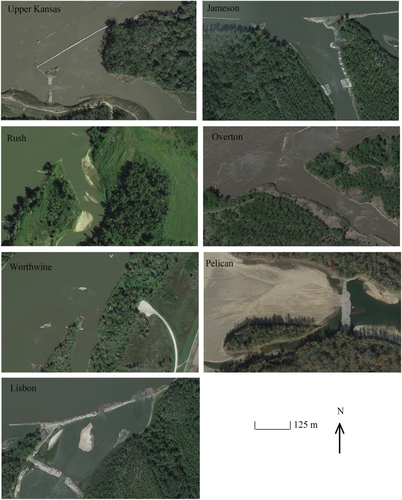
Aerial photograph of the inlet for each study chute.
Each site was sampled twice monthly, as water levels allowed, from May through September during 2012 and 2013. A variety of sampling gears were used to capture age-0 sturgeon, including a benthic sled, dual bow-mounted plankton nets, a bow-mounted push trawl (POT02), and a bow trawl (OT04), and samples were stratified by depth as each gear had a recommended range of depths for sampling. The benthic sled, similar to Yocum and Tesar (1980), utilized a 750-μm mesh conical net (0.75-m diameter with a 1:4 width to length ratio) mounted to a rectangular frame with runners that allowed benthic sampling in shallow, slow-water areas (<2 m deep). The dual bow-mounted plankton nets consisted of two of the same nets described above, mounted on a rigid frame, which could be adjusted from 0 to 2 m in depth. Nets were anchored stationary in the current or pushed slowly in areas of little to no current. For both plankton net gears, a General Oceanics model 2030R mechanical flowmeter was used to determine the volume of water filtered during deployment and catch per unit effort (CPUE) was calculated as the number of fish/100 m3. The POT02, a 4-mm-mesh push trawl (2.4 m wide with 0.76-m × 0.38-m otter doors), was used to sample depths up to 2 m. The OT04, a 4-mm-mesh bow trawl (4.9 m wide with 0.91-m × 0.38-m otter doors) was usually used to sample depths between 2 and 4 m, but during low water conditions this depth range was not always available in some chutes (e.g., Rush, Pelican), thus shallower samples were occasionally conducted by shortening the tow ropes. Sampling depths exceeding 4 m was usually avoided because Ridenour et al. (2011) rarely captured age-0 sturgeon at those depths. Catches for all benthic trawls were standardized by multiplying the trawl distance and the effective fishing width (Ridenour et al. 2011) and reported as fish/100 m2. Trawling was conducted according to the Missouri River Standard Operating Procedures for Fish Sampling and Data Collection (Welker and Drobish 2010).
During both years, sampling gear effort was adjusted to effectively capture age-0 sturgeon as they increased in size during the growing season. From May to July 2012, the benthic sled, dual bow-mounted plankton nets, and POT02 were used to sample age-0 sturgeon. Four benthic sled, four dual bow-mounted plankton net, and eight POT02 samples were collected during each sampling trip to each site and divided evenly between chute and adjacent main-stem habitats. During August–September 2012, eight POT02 and eight OT04 samples were collected during each sampling trip to each site and divided evenly between chute and adjacent main-stem habitats. Based on our 2012 efforts, we adjusted our sampling regime during 2013 to maximize age-0 sturgeon catch. From May to mid-July 2013, the POT02 was replaced with the MOT02, a 2-mm-mesh bow trawl (2.4 m wide with 0.76-m × 0.38-m otter doors). Eight benthic sled, four dual bow-mounted plankton net, and eight MOT02 samples were collected during each sampling trip to each site and divided evenly between chute and adjacent main-stem habitats. From mid-July to September 2013, eight POT02 and eight OT04 samples were collected during each sampling trip to each site and divided evenly between chute and adjacent main-stem habitats. Our suite of gears allowed sampling of each available habitat type in depths ≤ 4 m, and similar to Ridenour et al. (2011), main-stem thalweg and outside bend areas were excluded because of the inconsistency and potential safety risks associated with snagging gear in these fast, deep areas. Water depth was recorded to the nearest 0.1 m at the beginning, middle, and end of each sample run (except only one depth was recorded for stationary, anchored samples). When more than one depth was recorded, the mean depth was used for analyses. Water velocity was measured near the bottom with a Marsh–McBirney flowmeter at the middle of the each sample run. Age-0 sturgeon were measured for fork length when a well-defined fork in the caudal fin was present; however, total length (excluding the caudal filament) was also measured for small individuals lacking a well-defined fork (Braaten et al. 2007). Individuals ≤ 109 mm were considered age 0 (Ridenour et al. 2011) and individuals ≤ 23 mm were excluded from the depth and velocity analyses described below to minimize the potential for drifting larvae to be included in these analyses (i.e., individuals > 23 mm were considered exogenously feeding larvae).
To evaluate the differences in accessibility for age-0 sturgeon, both years of data were combined and pooled by gear type (i.e., sled and bow-mounted plankton nets were categorized as “plankton” and POT02, OT04, and MOT02 trawls were categorized as “trawl”). Main-stem samples at each site were also pooled by habitat type for comparison with chute CPUE. Ridenour et al. (2011) found that chutes “mimicked the velocity, depth, and substrate particle size of rootless dikes, wing dikes, and channel sandbars” and these three habitats also contained the highest catch rates of age-0 sturgeon during their study; thus, the pooling of main-stem samples was appropriate as these three habitats were the most frequently sampled during our study. This provided a valid comparison between chute CPUE and main-stem CPUE of fish that exited the thalweg and were potentially available to enter the chute (i.e., not entrained in the thalweg). Because of highly skewed data, we observationally compared CPUE (mean ± 95% confidence interval [CI]) for plankton nets between each paired chute and main-stem site. The same was done for the trawl data. Given the large amount of revetment rock blocking the entrances to Upper Kansas and Lisbon chutes, we expected these sites to have limited chute access. To compare depth and velocity at sites where sturgeon were captured and where they were absent within chute and main-stem habitats, a Kruskal–Wallis nonparametric analysis of variance (ANOVA) was used because the data did not meet normality assumptions; Dunn's multiple comparison procedure was used for all pairwise comparisons. Logistic regression was also used to determine if a significant relationship existed between the presence of age-0 sturgeon and water depth or velocity. Additionally, simple linear regression was used to assess length–depth and length–velocity relationships at chute and main-stem age-0 sturgeon capture sites. Significance was α = 0.05 for all tests.
RESULTS
During 2012 and 2013, all sites were sampled regularly, except Pelican. Low water levels only allowed one sampling trip to Pelican during 2012; however, water levels allowed seven sampling trips to this site during 2013. We conducted a total of 614 plankton (20 contained age-0 sturgeon) and 1,438 trawl (77 contained age-0 sturgeon) samples. A combined total of 165 age-0 sturgeon were captured (31 from plankton nets and 134 from trawls). Genetic analysis revealed that 158 age-0 sturgeon were Shovelnose Sturgeon Scaphirhynchus platorynchus; however, 11 individuals were unidentifiable. Mean length was 32.1 mm (95% CI, 6.2) and 38.0 mm (4.3) in chute and main-stem habitats, respectively. The dominance of zero catches for age-0 sturgeon resulted in highly skewed data with median, 25th percentile, and 75th percentile CPUE values equal to 0 at all sites for both plankton net and trawl data. Furthermore, 95% CI values were usually greater than mean CPUE values (Figure 4).
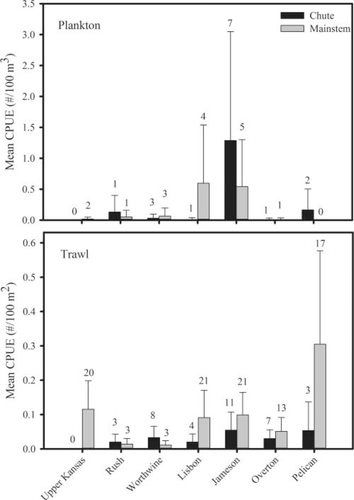
Age-0 sturgeon CPUE (mean ± 95% CI) for chute and adjacent main-stem habitats in the lower Missouri River using plankton (upper panel) and trawl (lower panel) gears. The number of sturgeon captured is provided above each bar.
Plankton samples appeared to yield relatively low mean CPUE for age-0 sturgeon at all sites, except Lisbon and Jameson (Figure 4). Access appeared limited in the Lisbon chute, as mean plankton CPUE was over 45 times higher in main-stem habitats than in the chute; in contrast, mean plankton CPUE in nearby Jameson chute was over twice that observed in adjacent main-stem habitats. Furthermore, Jameson chute had the highest mean plankton CPUE observed among all chute and main-stem habitats (Figure 4).
Trawl samples appeared to yield relatively low mean CPUE for age-0 sturgeon in chute and main-stem habitats at Rush, Worthwine, and Overton; however, mean trawl CPUE was relatively high in at least one of the habitats (i.e., chute or main stem) at Upper Kansas, Lisbon, Jameson, and Pelican (Figure 4). Access appeared limited in the Upper Kansas chute, where no age-0 sturgeon were captured despite adjacent main-stem habitats yielding the second highest mean trawl CPUE. Similarly, both Lisbon and Pelican mean trawl CPUE was over 4.5 times higher in the adjacent main-stem habitats than within each of these chutes. In contrast, Jameson mean trawl CPUE in main-stem habitats, although appearing higher, was less than twice that observed in the chute. Further, mean trawl CPUE in Jameson chute was still more than 2.5 times higher than in the nearby Lisbon chute, while adjacent main-stem CPUE at Jameson and Lisbon appeared identical (Figure 4).
Significant differences in depth existed in chute and main-stem habitats between sturgeon (exogenously feeding) capture sites and sites where sturgeon were not captured (nonsturgeon sites), with these sturgeon capture sites occurring in deeper water in both chute and main-stem habitats than nonsturgeon sites (Figure 5). Exogenously feeding age-0 sturgeon were usually sampled in water more than 1.5 m deep. Similarly, significant differences in velocity existed between sturgeon capture sites and nonsturgeon sites, with sturgeon capture sites occurring in faster water in chute habitats relative to nonsturgeon sites; in contrast, velocity was not significantly different between sturgeon capture sites and nonsturgeon sites in main-stem habitats. However, velocity at sturgeon capture sites tended to be near the upper end of the range of velocities observed at nonsturgeon sites in these main-stem habitats (Figure 5). Exogenously feeding age-0 sturgeon were usually sampled in water velocities greater than 0.5 m/s. Additionally, there was a relationship between the presence of exogenously feeding age-0 sturgeon and water depth, with the highest probabilities of presence occurring at depths ≥ 2 m in both chute and main-stem habitats (Figure 6). A relationship also existed between the presence of exogenously feeding age-0 sturgeon and water velocity, with the highest probabilities occurring at velocities ≥ 0.5 m/s in both chute and main-stem habitats (Figure 6). Furthermore, there was no relationship between exogenously feeding age-0 sturgeon length and water depth or water velocity in chute habitats; the same was true between length and water velocity in main-stem habitats (Figure 7). Relationships did exist between exogenously feeding age-0 sturgeon length and water depth in main-stem habitats; however, very little variation was explained by the regression model (Figure 7).
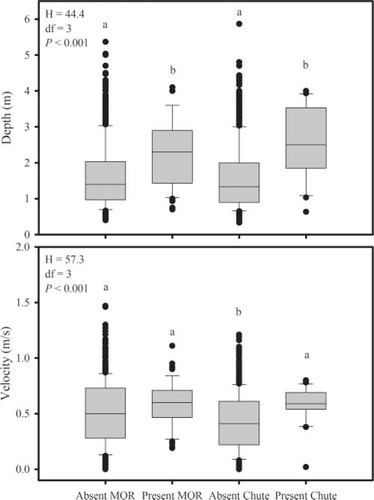
Box plots of depth (upper panel) and velocity (lower panel) at exogenously feeding age-0 sturgeon (present) and nonsturgeon (absent) chute and main-stem (denoted as MOR) sites. The horizontal line in each box indicates the median, the box dimensions represents the 25th and 75th percentiles, the whiskers represent the 10th and 90th percentiles, and the black dots are outliers. Box plots with the same letter are not statistically different at α = 0.05.
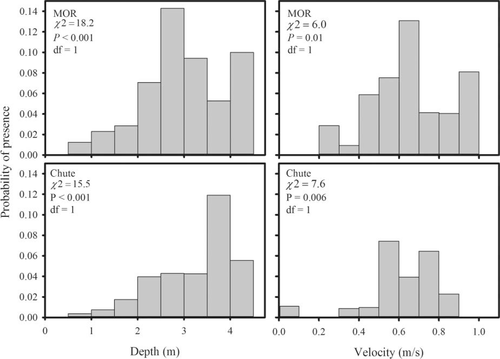
Probability of presence for exogenously feeding age-0 sturgeon by water depth and velocity in chute and main-stem (MOR) habitats.

Scatter plots of the length of exogenously feeding age-0 sturgeon by depth and velocity in chute and main-stem (MOR) habitats. The significant linear regression relationship is denoted with a trend line.
DISCUSSION
The consideration of project-level refinements, such as modifying existing chute inlet control structures that may improve access without negatively affecting other authorized Missouri River purposes, may be warranted because it appears that age-0 sturgeon accessibility is limited at some chute sites. This was most evident at the Upper Kansas chute, where no age-0 sturgeon were captured despite a relatively high trawl catch in nearby main-stem habitats; similar findings were observed at Lisbon chute. Access also appeared limited at Pelican chute. Given this information, our findings support previous research suggesting that limited chute accessibility may be an issue for age-0 sturgeon (Ridenour et al. 2011). In contrast, Jameson chute, located on the next bend downstream of Lisbon, appeared to provide the best opportunity for age-0 sturgeon chute access despite main-stem plankton and trawl mean CPUE being nearly identical to Lisbon main-stem habitats. Interestingly, Jameson has a more open inlet design coupled with a unique V-shaped grade control structure specifically designed to allow access to deep-drifting sturgeon larvae.
As expected, the sites appearing to limit age-0 sturgeon accessibility (Upper Kansas, Lisbon, and Pelican chutes) had designs consistent with highly restrictive chute inlet control structures relative to the other chutes. At normal to low river levels, only a small notch in the chute inlet control structure would allow free-embryo drift into the Upper Kansas and Lisbon chutes. Furthermore, Pelican not only has a relatively restrictive control structure, it is perched compared with the main stem of the river, further deterring free-embryo drift during low water levels (i.e., Pelican often experienced minimal to nonexistent flow when the other chutes were still flowing). Even during high water, these structures may limit age-0 sturgeon access. For example, the majority of free-embryo sturgeon drift is near the bottom (Braaten et al. 2008, 2010), thus, even when these inlet control structures are overtopped during high water, young sturgeon may not be capable of successfully drifting over these structures. Woodward and Rus (2011) found that chute inlet control structures limited the amount of Missouri River course-grained suspended sediment entering Upper Hamburg and Glovers Point chutes, demonstrating the potential barrier that these structures may pose to other objects drifting near the bottom, such as sturgeon larvae. While inlet structure design likely plays a major role in chute accessibility, other factors (e.g., chute inlet location on the bend, inlet location relative to the thalweg, location of other river training structures, and the interaction of these factors) may also contribute to this issue, warranting further investigation of these potential factors. Additionally, the location of constructed SWH restoration sites relative to spawning locations may affect the ability of chutes to provide nursery habitat for age-0 sturgeon. Although we sampled sites along a longitudinal gradient spanning over 850 km and captured exogenously feeding age-0 sturgeon at each site, a better understanding of age-0 sturgeon drift dynamics in the LMOR would provide important insight towards identifying the most appropriate location for habitat restoration projects designed to increase age-0 sturgeon nursery habitat. Modeling simulations conducted by Erwin and Jacobson (in press) in the LMOR provided important baseline information; however, the authors concluded that additional research is needed because a lack of data limited their ability to completely describe the relationships regarding free-embryo dispersion.
While drifting age-0 sturgeon may be most susceptible to limited accessibility, exogenously feeding fish that did not enter the chute via the inlet during their free-embryo drift period may also experience limited access. As such, age-0 sturgeon entering the chute via the downstream outlet may have had little effect on our comparisons between chute and main-stem habitats because access via the chute outlet would require exogenously feeding sturgeon to be able to hold position after settling and then swim upstream in order to enter a chute. Laboratory studies indicated that recently settled age-0 sturgeon (Kynard et al. 2007), as well as individuals up to 75 mm total length (D. Deslauriers, South Dakota State University, unpublished data), may have difficulty holding position in water velocities that are relatively slow within the LMOR (e.g., ≤ 0.3 m/s). Furthermore, even if exogenously feeding sturgeon can hold position, these fish may experience a velocity barrier preventing them from swimming upstream into the chute as currents can be turbulent and swift at downstream chute outlets, particularly during higher water levels that are common during the free-embryo drift period. Thus, if age-0 sturgeon are not able to access the chute through the inlet during or shortly after the free-embryo drift period, these fish may not be able to gain access via the outlet in sufficient time to take advantage of the potential nursery habitat within a chute. It is possible that some exogenously feeding age-0 sturgeon were able to access these chutes via the downstream outlet and, after entering the chute, returned to main-stem habitats instead of remaining in the chute, which may have affected our results. However, this was unlikely based on the laboratory studies cited above and the small size of age-0 sturgeon typically captured during this study (e.g., over 75% of the age-0 sturgeon sampled were < 50 mm).
Interestingly, it has been suggested that slow and shallow areas may have little direct benefit as nursery habitat (e.g., refuge, foraging, and growth) for age-0 sturgeon in the LMOR (Ridenour et al. 2011). During our study, exogenously feeding age-0 sturgeon were usually sampled from sites with greater depths and faster velocities relative to nonsturgeon sites in both chute and main-stem habitats. Additionally, the probability of presence for exogenously feeding age-0 sturgeon was highest at depths ≥ 2 m and velocities ≥ 0.5 m/s in both chute and main-stem habitats. Our results were similar to Ridenour et al. (2011), who found Missouri River age-0 sturgeon were usually sampled from depths more than 1.5 m and velocities of 0.5–0.7 m/s. Similarly, contingency sampling on the LMOR during the high water event of 2011 found a mean depth of 3.2 m and a mean velocity of 0.57 m/s for small sturgeon ≤ 200 mm (Ridenour et al. 2012). Phelps et al. (2010) also reported that middle Mississippi River age-0 sturgeon were usually sampled at depths of 2–5 m; however, these sturgeon were usually found in slow velocities around 0.1 m/s. Our results, coupled with previous research, may support findings that the combination of slow and shallow habitats may not be as important to age-0 sturgeon as expected. However, other possible explanations exist; for example, minimizing human disturbance is more difficult in shallow areas (e.g., the boat and motor pass through the sampling zone before the net for the sled, MOT02, and OT04 gears), which may affect catch rates. Additionally, Ridenour et al. (2011) suggested that age-0 sturgeon may only use slow habitats (e.g., ≤ 0.2 m/s) shortly after settling out of the drift (e.g., 20–30 mm in length) before moving to faster areas. Our results, however, showed little to no relationship between exogenously feeding age-0 sturgeon length and water depth or velocity in chute or main-stem habitats. Furthermore, only 6% of the exogenously feeding age-0 sturgeon up to 30 mm long were sampled from sites with velocity ≤ 0.2 m/s; however, it is possible that some of the individuals that were sampled in the faster, deeper water may have been entrained by these currents. Little is known about the size at which age-0 sturgeon begin choosing their habitat, and an improved understanding in this area would allow researchers to more conclusively determine if age-0 sturgeon actually prefer fast and deep habitats or if they simply have difficulty navigating to slow and shallow areas in the highly engineered, self-scouring LMOR.
Adaptive management is founded on the principles of learning through doing and translating lessons learned into project refinements, if needed. This study suggests that the potential benefits of chute habitat use by age-0 sturgeon may not be maximized due to limited accessibility at some sites; however, numerous SWH chute construction projects are still in the planning stages (Gosch et al. 2013), providing an opportunity to consider potential access-friendly designs (e.g., a V-shaped design similar to Jameson chute) before construction begins. Regardless of accessibility, however, it is still unknown whether increased habitat availability results in increased survivorship of age-0 sturgeon and subsequent population growth. The primary hypothesis linking SWH restoration to population growth is based on the assumption that poor larval survival, due to reduced nursery habitat (USFWS 2000), is currently limiting Pallid Sturgeon populations. If this assumption is false (e.g., larval survival is not low or more critical limitations occur before sturgeon settle from the drift), the evaluation of additional hypotheses regarding increased Pallid Sturgeon survival and population growth is warranted. Additionally, our data are consistent with previous research suggesting that slow and shallow habitats may not be used by age-0 sturgeon as frequently as other habitat types (Ridenour et al. 2011). This does not necessarily suggest that shallow and slow habitat is not limiting to Pallid Sturgeon or that SWH projects cannot provide the desired benefits; however, future research should focus on determining if habitat availability is a limiting factor for Pallid Sturgeon and, if so, what type of habitats are required for increased survivorship and population growth.
ACKNOWLEDGMENTS
We thank Anthony Civiello, Kevin Montemayor, Jerrod Hall, and Ken Hatten, as well as numerous other U.S. Army Corps of Engineers and Nebraska Game and Parks Commission staff for field assistance. Michael Chapman, Daniel Pridal, Tim Welker, and Heather Hill provided valuable comments on an earlier draft of this manuscript. This study was funded by the U.S. Army Corps of Engineers Kansas City District. The contents of this report are not to be used for advertising, publication, or promotional purposes. Reference to trade names does not imply endorsement by the U.S. Government. All product names and trademarks cited are the property of their respective owners. The findings of this report are not to be construed as an official Department of Army position unless so designated by other authorized documents.



